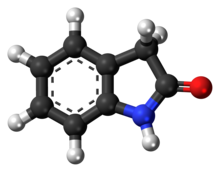Oxindole

| |

| |
| Names | |
|---|---|
| Preferred IUPAC name
1,3-Dihydro-2H-indol-2-one | |
| Identifiers | |
3D model (JSmol)
|
|
| 114692 | |
| ChEBI | |
| ChEMBL | |
| ChemSpider | |
| ECHA InfoCard | 100.000.390 |
| EC Number |
|
| 637057 | |
| KEGG | |
| MeSH | Oxindole |
PubChemCID
|
|
| RTECS number |
|
| UNII | |
CompTox Dashboard(EPA)
|
|
| |
| |
| Properties | |
| C8H7NO | |
| Molar mass | 133.150g·mol−1 |
| Appearance | pale yellow solid |
| Melting point | 128 °C (262 °F; 401 K) |
Except where otherwise noted, data are given for materials in theirstandard state(at 25 °C [77 °F], 100 kPa).
| |
Oxindole(2-indolone) is anaromaticheterocyclicorganic compoundwith the formula C6H4CHC(O)NH. It has a bicyclic structure, consisting of a six-memberedbenzenering fused to a five-memberednitrogen-containing ring. Oxindole is a modifiedindolinewith a substituted carbonyl at the second position of the 5-member indoline ring. Classified as a cyclic amide, it is a pale yellow solid.
Formation and reactions
[edit]Oxindole is derived in nature fromtryptophan,formed by gut bacteria ( "normal flora" ). It is normally metabolized and detoxified from the body by the liver. In excess, it can cause sedation, muscle weakness, hypotension, and coma. Patients withhepatic encephalopathyhave been recorded to have elevated serum oxindole levels.[1]
Treatment withphosphorus pentasulfidegives thethione.
Oxindoles
[edit]
Beyond, the parent compound, oxindoles include many compounds,[3]for example 3-methyloxindole[4]andsemaxanib.[5]
References
[edit]- ^Riggio, Oliviero; Mannaioni, Guido; Ridola, Lorenzo; Angeloni, Stefania; Merli, Manuela; Carlà, Vincenzo; Salvatori, Filippo Maria; Moroni, Flavio (2 February 2010). "Peripheral and Splanchnic Indole and Oxindole Levels in Cirrhotic Patients: A Study on the Pathophysiology of Hepatic Encephalopathy".The American Journal of Gastroenterology.105(6): 1374–1381.doi:10.1038/ajg.2009.738.PMID20125128.S2CID20633097.
- ^Kang TH, Murakami Y, Matsumoto K, Takayama H, Kitajima M, Aimi N, Watanabe H (2002). "Rhynchophylline and Isorhynchophylline Inhibit NMDA Receptors Expressed inXenopusOocytes ".European Journal of Pharmacology.455(1): 27–34.doi:10.1016/S0014-2999(02)02581-5.PMID12433591.
- ^Trost, Barry; Brennan, Megan (2009). "Asymmetric Syntheses of Oxindole and Indole Spirocyclic Alkaloid Natural Products".Synthesis.2009(18): 3003–3025.doi:10.1055/s-0029-1216975.
- ^Abraham S. Endler and Ernest I. Becker (1957). "3-Methyloxindole".Org. Synth.37:60.doi:10.15227/orgsyn.037.0060.
- ^Lubkoll, Jana; Millemaggi, Alessia; Perry, Alexis; Taylor, Richard J.K. (2010). "Tandem Horner–Wadsworth–Emmons/Heck procedures for the preparation of 3-alkenyl-oxindoles: The synthesis of Semaxanib and GW441756".Tetrahedron.66(33): 6606–6612.doi:10.1016/j.tet.2010.03.018.
